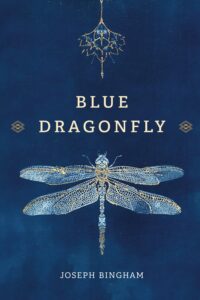Today, we’re talking with Joseph Bingham about his book, Blue Dragonfly.
 Tell us something unexpected about yourself!
Tell us something unexpected about yourself!
I had a pet black widow spider when I was a young teen. I kept it in an empty peanut butter jar and fed it hornets that found their way into my basement study through a crack in the window. That same make-shift study was also where I kept my insect collection, which was housed in empty cigar boxes, and my cheap microscope, which I used to study protozoa. I grew the one-celled animals in bottles filled with stinky pond water. As you can imagine, I was not a typical young man. My wife says it best by claiming I’m too much like Pedí, the male protagonist in my book—strange, nerdy, and more comfortable talking to the gopher snakes I find and pick up than I am to people. She also says my best friends are the fantasy ones I write about.
Why do you write?
I have always enjoyed reading. In grade school, I walked once a week to our local library and brought home a stack of books. My first fantasy reads were the Wizard of Oz stories by L. Frank Baum. I read all of them. Soon, my reading, besides fiction and fantasy, included nature books, especially those about entomology, herpetology, and paleontology. Deciding to write was an extension of my joy and interest in reading a good story or learning new facts in a book. I loved to make up and tell stories to my children when they were young, and I have continued doing it with my grandchildren. The stories often contain some creature from the natural world, but I like to pepper the tale with a bit of fantasy. After I retired from work, I chose to try to write a story that would include all my interests. But with no experience writing, I started the learning process. It has taken me over ten years to get my story ready for publication.
Where did you get the inspiration for your current book?
I consider myself an amateur entomologist and herpetologist, so writing about insects, frogs, and snakes is natural. They are a big part of my story. The tropical world I created in Blue Dragonfly comes from several things. One of my favorite books is White Waters and Black. I read it for the first time as a teen. It tells the story of a scientific expedition to Bolivia and Brazil in the 1920s. The stories of their adventures in the tropics fascinated me, and I desired to experience South America myself. Later, I was able to live in Brazil for several years and learned Portuguese, which I speak fluently. Tropical diseases are another subject that I have woven into my story. When I went to medical school, I desired to pursue a speciality that would include tropical medicine. However, my wife had twins while we were still in medical school, and suddenly, having a young family did not seem a good option for pursuing a career that might include living and working out of the country. However, after my children were grown, I got additional training in tropical medicine. I went to Africa and the Amazon several times with organizations bringing healthcare to people in need.
What do you enjoy the most about your genre?
I have found the young adult genre to be one in which, depending on the subject matter, middle-graders and older adults can also read and enjoy. I like the diversity of readers. The fantasy in my story is more magical realism, where the tropical world of Pedí and Adací is similar to ours and where the magic or fantasy is woven into the world without overwhelming it.
How would you describe your writing process?
Long! When I first decided to write a book, I talked to my son, who has some writing skills. His advice at the time was to start getting my stories down, even in my worst way, and then figure out the best way to express them later. I began attending writing conferences, purchased books on how to write, subscribed to Writer’s Digest, and got the help of several freelance editors. Blue Dragonfly was written and re-written over a hundred times. Nevertheless, though difficult, the journey was delightful, as I spent time with my fantasy friends.
What do you think authors have to gain from participating in social media?
You are asking the wrong person. I’m an old guy with little experience with Instagram, TikTok, and other social media. I understand it is a great way to communicate with others and share my book, but I will have to learn how to do it.
 What advice would you have for other writers?
What advice would you have for other writers?
Write about things you are interested in. Find joy in your characters. Keep trying and learning.
How do you select your books’ titles and covers?
The title comes from a mythical insect creature with magical powers that Pedí’s ancestors used to worship. Pedí searches for one all his life. Because of the title, my son suggested I make a cyanotype book cover. The blue of cyanotype art is always fascinating. I started experimenting with cyanotypes, but in the meantime, my wife found a perfect cyanotype dragonfly art piece online. Arianna Guirola created it. Arianna’s art is beautiful, and I immediately knew her dragonfly was what I wanted for my cover. Fortunately, Arianna gave me her permission to use the dragonfly.
What’s your next step?
Though Blue Dragonfly has an ending, it opens the door for more adventures. I have already sketched out many ideas and have written parts of the next story, but I have not yet launched into the full writing of the sequel. I have a complete draft of another book, a non-fantasy contemporary story. I may also continue working on it as well.


